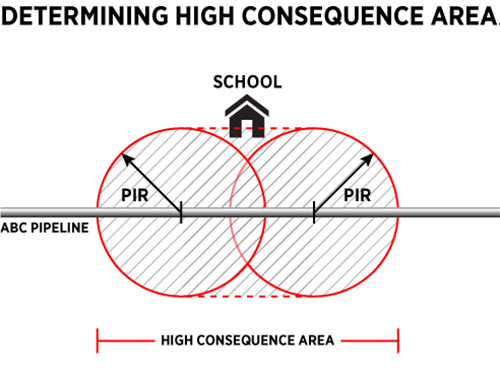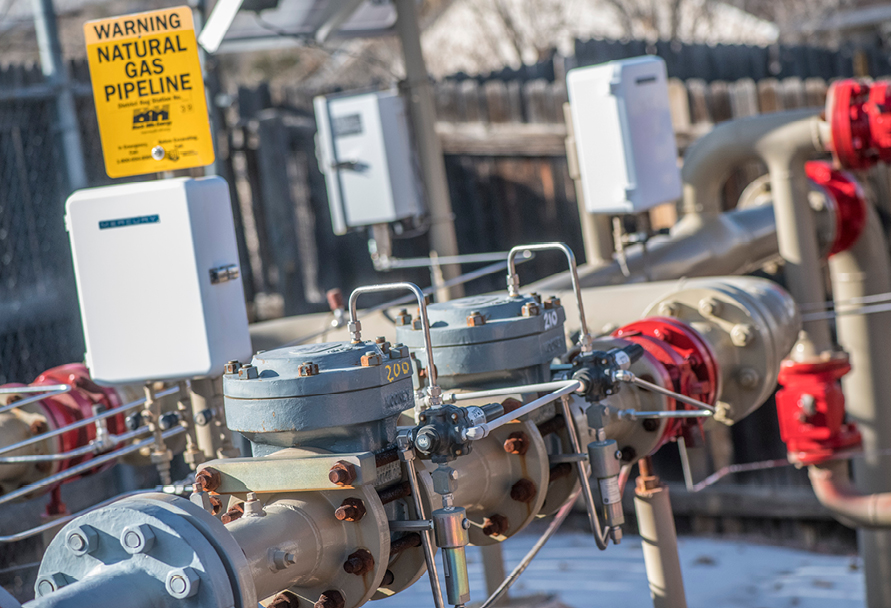Pipeline integrity management program
At Black Hills Energy, we’re committed to protecting the public, our employees, public and private property, and the environment as whole — all while providing reliable service to our customers. Pipeline integrity management plays an important role in preventing interruption to our customers’ energy service, maintaining our system integrity and preserving our investments for future generations.
As part of our integrity management strategy, we assess the integrity of our pipelines when they’re initially installed and we continue to review it throughout each pipeline’s service life. This occurs through periodic inspections and testing as well as historical data review.
The objective of our Integrity Management Program is to improve pipeline safety through a systematic approach involving data gathering, risk assessment, integrity assessments, prevention, and mitigation. The Pipeline and Hazardous Materials Safety Administration (PHMSA) has developed specific High Consequence Area (HCA) and Moderate Consequence Area (MCA) regulations for the operations and maintenance of pipeline segments in populated areas. These regulations are more rigorous than pipeline segments outside of HCAs and MCAs, and focus integrity management activities in areas where failure can cause the most harm.
At Black Hills Energy, safety is our number one priority, and we generally apply more rigorous measures to the operation of all our pipeline facilities, not just what we’re required to do.
However, we can’t be everywhere at once. Damage to pipeline facilities can occur in between inspections that we may not know about. Neighbors like you can assist us in maintaining a safe, secure, and reliable pipeline system. If you observe any unusual or suspicious activity near our pipeline facilities, or if an emergency occurs, please call us immediately at 888-890-5554.
We might also:
- Perform a risk analysis on a pipeline to see if there’s anything else we should do to increase public safety.
- Install automatic shut-off valves or remote-controlled valves to minimize the impact of leaks.
- Install computerized monitoring and leak-detection systems.
- Replace certain segments with pipe made of heavier wall thickness.
- Provide additional training to personnel about response procedures.
- Conduct drills with local emergency responders and implement additional inspection and maintenance programs.
High Consequence Area (HCA) means:
The radius within which the failure of a pipeline could have significant impact on people or property. A potential impact radius (PIR) is determined using a mathematical formula.
Identified site means:
- An outside area or open structure occupied by 20 or more people on at least 50 days in any 12-month period. The days don’t have to be consecutive.
- A building that is occupied by 20 or more people on at least five days a week for 10 weeks in any 12-month period. The days and weeks don’t have to be consecutive.
- A facility occupied by anyone who is confined, impaired mobility or would be difficult to evacuate.
When a High Consequence Area (HCA) is identified using a PIR, the length of the HCA extends along the pipeline from the outermost edge of the first potential impact circle that contains an identified site, or 20 or more buildings intended for human occupancy, to the outermost edge of the last potential impact circle that contains an identified site or 20 or more buildings intended for human occupancy.
The picture below provides a graphical example of this:

Moderate Consequence Area (MCA) means:
- An onshore area that is within a potential impact circle, as defined in §192.903, containing either:
- Five or more buildings intended for human occupancy; or
- Any portion of the paved surface, including shoulders, of a designated interstate, other freeway or expressway, as well as any other principal arterial roadway with four or more lanes, as defined in the Federal Highway Administration’s Highway Functional Classification Concepts, Criteria and Procedures, Section 3.1, and that does not meet the definition of an HCA, as defined in §192.903.
- The length of the MCA extends axially along the length of the pipeline from the outermost edge of the first potential impact circle containing either:
- Five or more buildings intended for human occupancy; or
- Any portion of the paved surface, including shoulders, of any designated interstate, freeway or expressway, as well as any other principal arterial roadway with four or more lanes, to the outermost edge of the last contiguous potential impact circle that contains either five or more buildings intended for human occupancy, or any portion of the paved surface, including shoulders, of any designated interstate, freeway or expressway, as well as any other principal arterial roadway with four or more lanes.
High consequence areas vs. moderate consequence areas
| Criteria | HCA | MCA |
|---|---|---|
| Within the PIR: | ||
| Buildings | 20 or more | 5-19 |
| Outside area | 20 or more people | N/A |
| Identified Sites | 20 or more people, or occupied by persons who would be difficult to evacuate | N/A |
| Roadways | N/A | Principal roadway with 4 or more lanes, expressways, interstate, freeways |
old content
There are many critical reasons to maintain the integrity of a pipeline. We want to make sure we’re always protecting the public, employees, property and the environment. Pipeline integrity management also plays an important role in preventing interruption to your energy service and to maintaining our system integrity and preserving our investments.
As part of the plan, we assess the pipeline’s integrity when it’s installed. After that, we’ll keep checking the pipeline’s integrity through continuous inspections and testing. And we also check the pipeline’s historical data.
We might also
- Do a risk analysis on a pipeline to see if there’s anything else we should do increase public safety and to protect what’s called a “high consequence area.”*
- Install automatic shut-off valves or remote control valves.
- Install computerized monitoring and leak-detection systems.
- Replace certain segments with pipe made of heavier wall thickness.
- Provide additional training to personnel about response procedures.
- Conduct drills with local emergency responders and implement additional inspection and maintenance programs.
*High consequence area means
- The area within a potential impact circle** that has 20 or more buildings intended for human occupancy.
- The area within a potential impact circle that has an identified site.***
**Potential impact radius means
- The radius of a circle within which the failure of a pipeline could have significant impact on people or property. The PIR is determined using a mathematical formula.
***Identified site means
- An outside area or open structure occupied by 20 or more people on at least 50 days in any 12-month period. The days don’t have to be consecutive.
- A building that is occupied by 20 or more people on at least five days a week for 10 weeks in any 12- month period. The days and weeks don’t have to be consecutive.
- A facility occupied by anyone who is confined, impaired mobility or would be difficult to evacuate.
When an HCA is identified using a potential impact radius, the length of the HCA extends along the pipeline from the outermost edge of the first potential impact circle that contains an identified site or 20 or more buildings intended for human occupancy to the outermost edge of the last potential impact circle that contains an identified site or 20 or more buildings intended for human occupancy.
The picture below provides a graphical example of this:
-->